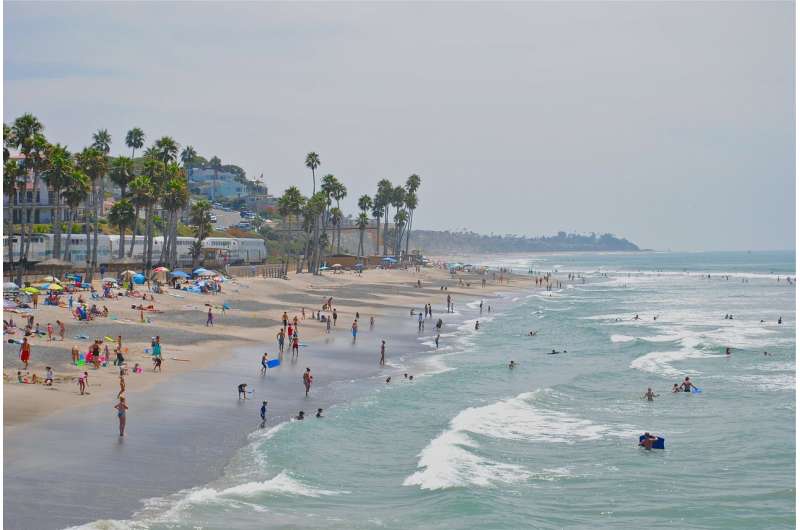Credit: CC0 Public Domain
Painted on a prominent wall at Viasat's latest headquarters expansion is the phrase, "There is always a better way."
It's the engineering mantra for the Carlsbad, Calif., satellite Internet and defense communications firm—perhaps best known for powering in-flight Wi-Fi for American Airlines, JetBlue, United Airlines and government VIP aircraft.
The theme has spread beyond Viasat's engineering department. It served as the linchpin concept for the company when designing and building its new East campus—the first phase of which debuted for employees this month.
"We kind of adopted that for facilities," said Bob Rota, a vice president for buildings and security at Viasat. "The architectural design was inspired by a number of factors, which included making the space about our employees first, as well as adding an element of the unexpected."
The first phase of the expansion project added 180,000 square feet in two buildings and a parking structure.
The second phase, which is expected to open in February, will add an additional 173,000 square feet, with more parking garages.
The campus expansion is being driven by the company's growth. Revenue increased 24 percent for the first six months of Viasat's current fiscal year to $956 million.
The company owns three satellites and has a long-term lease on another. With its most recent ViaSat-2 satellite, it can deliver up to 100 megabits per second speeds to customers—significantly faster than other Internet options outside the reach of cable.
Viasat is building three more satellites—each with one terabit of capacity—that will give it massive bandwidth in orbit. (A terabit equals 1,000 gigabits.) The new satellites will enable even faster speeds and expand Viasat's footprint globally. The first is set to launch in late 2020.
Founded in 1986, Viasat has been at its current Carlsbad location since 1999. Two years ago, it added the 198,000-square-foot North campus on 14 acres. It is the home of Viasat's in-flight Wi-Fi business. Sections of fuselages of a Boeing 737 and Gulfstream 4 are on display to demonstrate its technology.
The new East campus expansion sits on 23 acres and brings Viasat's total space in Carlsbad to 1.1 million square feet in 17 buildings. The company employs more than 2,500 workers in Carlsbad today and nearly 5,500 globally.
To get around the sprawling campus, Viasat provides about 100 beach cruiser bicycles for employees. New East campus buildings feature planked walkways to mimic an ocean pier. Surfboards hang on walls. Beach themed murals from local artists are featured—all aimed to reflect the vibe of North County.
In an era where tech companies increasingly rely on workplace amenities to attract talent, Viasat designed a 4 acre outdoor plaza with hammocks, couches, TV screens and Internet connectivity at its new East campus. Indoor conference rooms adjacent to the plaza have receding glass walls—creating large indoor/outdoor meeting spaces.
"Years ago we did not have the outdoor amenities we have now," said Rota. "People say it's for millennials. But all employees use it."
The campus also has a 10,000 square-foot atrium, cafes, putting greens, collaborate work spaces, food stations with separate daily menus—even a jungle themed work area that's part of an effort to deliver "elements of surprise."
Chief Executive Mark Dankberg said amenities aren't necessarily a requirement in the arm's race to attract top tech talent.
But the perks do help—not only in recruiting but also with retention.
"We have had very low turnover historically, and that is a big advantage for us," said Dankberg. "People do very complicated things. They learn a lot over time, so retention is a big deal for us."
They also help workers feel appreciated, said Dankberg.
"I feel people work really hard," he said. "When we launch new satellites, or we bring out new products, I think the level of commitment is really high. So to me, it all sort of goes together. You want a good place to work. They spend a lot of time here. We want them to feel like it is a good place to spend time."
The new campus was also designed with energy efficiency in mind—though the company did not seek the green building Leadership in Energy and Environmental Design, or LEED, certification.
Thirty-three percent of roof space has solar panels, which the company expects to help offset energy usage. The campus qualified for San Diego Gas & Electric's Savings by Design program.
"The expanded campus represents a global Viasat—from our people and culture to our technology and services," said Rick Baldridge, company president and chief operating officer. "With more than eight hours a day spent in the office, we wanted to create an environment that was casual, comfortable and encouraged our team to be inspired."
©2019 The San Diego Union-Tribune
Distributed by Tribune Content Agency, LLC.




















